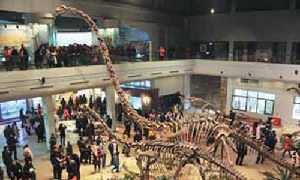Zigong's heart is below the surface
 |
|
Zigong Dinosaur Museum has one of the world's largest dinosaur fossil collections. Xiao Mi / for China Daily |
Zigong is a place that can be summarized in two words: dinosaurs and salt.
Located about 90 minutes by car from Sichuan's provincial capital Chengdu, the city is a perfect destination for a day trip, where you can get up close and personal with dinosaurs from the Jurassic era and visit the 2,000-year-old salt wells.
Zigong Dinosaur Museum, located in a national geopark, displays one of the largest dinosaur fossil collections in the world.
Built on an archaeological excavation site, it was a dinosaur habitat in the Jurassic age.
There are traces of many species of dinosaurs - bones, eggs, footprints and even rare skin fossils. The proud exhibits include Huayangosaurus taibaii, the most primitive and complete stegosaur in the world; the first-discovered tail clubs of Shunosaurus and Omeisaurus; and the first-discovered stegosaur skin fossil in the world.
More treasures of Zigong lie underground - salt and natural gas. The combination of the two has made Zigong a center of salt-making and salt trade since ancient times, which had brought wealth and cultural wealth to the city.
A 200-year-old salt well is still working and open to visitors. The 1,014-meter deep Shenhaitian is the first man-made well in the world that exceeds 1,000 meters.
Take a look and get a hint of how precious salt comes into being deep underground.
A place that produces salt will always boast its special dishes. Zigong dishes are called Salt Gang, tasty beef with pepper and ginger toppings. Beef was introduced into Sichuan cuisine because the salt wells once needed cattle to work the machinery.
With Salt Gang dishes rising in popularity all over the country, it's interesting to go back to the origin and taste the flavor that had passed down from the families of salt traders.
meijia@chinadaily.com.cn














